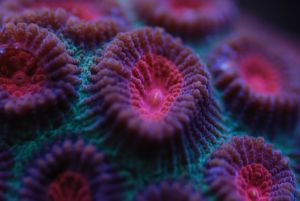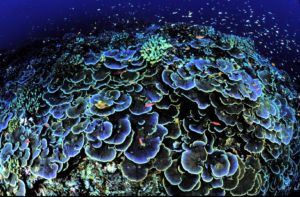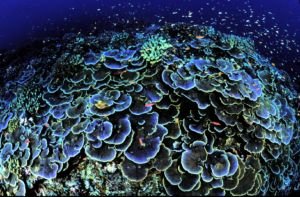New article on our website: https://chaosaquaculture.com/sps-an...UCEqBER4a2HtXLdAam69_R8nnkhkdMMcz3ebLlHSZgE5w
Corals are among the most diverse and beautiful species of animals on the planet.
LPS coral and SPS coral make for amazing pets but require certain knowledge and equipment.
Coral Biology 101
As with any animal, it is necessary to appreciate and understand their biology in order to best care for them.
Polyps are individual organisms that make up colonies of corals and anemones. Different species of polyps coalesce to form coral reefs. Countless types of fish and other marine life depend on the coral reefs for shelter.
Their vibrant colors and dreamlike shapes have captured the fascination of many marine biologists and nature lovers throughout history. Ernst Haeckel’s illustrations brilliantly present their dazzling geometry. They can make unique pets that will stand out in any room of the house.
Unfortunately, changes in the aquatic ecosystems have devastated many coral reefs across the oceans. Much of this is due to human activity.
What Kinds of Corals are there?
More than two thousand species of corals have been described. They have a diverse and complex family tree. Most can be categorized as soft or hard corals, and the latter use calcium carbonate to strengthen their skeleton.
For this article we will focus on hard corals. Two of the most popular types of coral for home saltwater aquarium enthusiasts are large polyp stony (LPS) and small polyp stony (SPS) corals.
The type of coral you choose will determine the maintenance it requires. Inform yourself so you can choose what best suits your needs.
Getting Started
You will need to make an investment of time and money to own and maintain healthy corals in your home aquarium.
What You Will Need:
LPS Coral
SPS Coral
Feeding: Direct vs Indirect vs Zooxanthellae Algae

Zooxanthellae Algae
Zooxanthellae algae are a type of plankton that live in symbiosis with coral, jellyfish, and other ocean creatures. They rely on photosynthesis for energy. The host coral provides the zooxanthellae with shelter, nutrients, and an elevated position to receive extra sunlight. In return, the coral receives up to 90% of its energy and oxygen requirements from the products of photosynthesis.
Great results will happen when you routinely spot-feed 2-3 times per week or broadcast feed 1-2 capfuls per 10 gallons. Whenever possible, it is best to spot-feed corals and filter feeding inverts from a small syringe or baster.
Direct Feeding
Corals with larger tentacles and mouths can be fed directly with macroscopic prey. This includes shrimp, fish, squid, krill, phytoplankton, and others. This type of feeding is appropriate for many types of LPS coral.
It is good idea to buy coral food that comes in a variety of particle sizes. Different size polyps will prefer different sizes and types of seafood. It is best to have variety in both food type and particle size.
Indirect Feeding
This occurs when coral absorbs dissolved nutrients from the water. This happens naturally when fish eat food and then excrete the nutrients that the coral can then use.
You can mimic this process in your own home. Clownfish, damselfish, firefish, and blue-green chromis are examples of fish that make good neighbors for coral. Be sure that you buy LPS fish food that will contain ingredients that coral can utilize, such as plankton and shrimp.
Lighting
Corals need light to survive. Remember, corals depend on the photosynthetic zooxanthellae that live in them for energy and oxygen. This is why corals are only found in shallow ocean water.
Generally speaking, hard corals require more light than soft corals. SPS corals have higher lighting demands than LPS corals. SPS/LPS corals do best with very high output (VHO) fluorescent lighting. Alternatively, compliment non-VHO T5 fluorescent lighting with reflectors.
Keep in mind that using high-powered lights will probably generate a spike in your electric bill.
Flow requirements
Water currents help corals eat, get rid of waste products, reproduce, and carry out biochemical processes such as photosynthesis and respiration.
Too little current results in dead zones of stagnant water, and the nutrients will not disperse evenly throughout the tank.
Signs of too much current include the presence of sand piles from being pushed around. The flow may even be strong enough to kick up from the bottom of the tank.
Most LPS corals do best with a medium current. If the flow is at the right setting, the longer tentacles present on some corals, such as Euphyllias, will be extended and should gently sway with the current.
SPS corals require a stronger flow than LPS corals. This is because they need better water quality to thrive.
Toxins: Nitrates and Phosphates
Maintaining a healthy saltwater aquarium depends on keeping toxins at acceptable concentrations. Two of the most common offenders that can accumulate and devastate your corals are nitrates and phosphates.
They promote the growth of toxic algae blooms, a condition known as green water. Also, nitrates hurt the ability of SPS coral to produce their skeleton.
Bacteria living in your aquarium act as natural filtration system. They produce nitrates as a byproduct after breaking down ammonia and nitrites, which are extremely harmful. Unfiltered tap water or certain sea salt mixes can be another source of unwanted nitrates.
Phosphates are produced naturally in your aquarium. Decaying plants, left over food, fish feces, dead fish, contaminated water, and commercial aquarium chemicals are all potential sources.
Final Thoughts
LPS coral and SPS coral make great pets for serious enthusiasts. They are fascinating to watch and will surely wow your guests.
But no one is going to be impressed by your bleached, dying coral. Not to mention, neglecting them is akin to animal cruelty.
So make sure you are prepared to take on this responsibility. Don’t go it alone. Count on us for all your saltwater aquarium and coral needs.
SPS and LPS Coral: Your Guide to Care and Feeding

Sworls of Montipora aequituberculata, a core coral, attract fish at Jarvis Island National Wildlife Refuge in the Pacific, about 1,300 miles southwest of Honolulu. (Jim E. Maragos/USFWS)
Corals are among the most diverse and beautiful species of animals on the planet.
LPS coral and SPS coral make for amazing pets but require certain knowledge and equipment.
Coral Biology 101
As with any animal, it is necessary to appreciate and understand their biology in order to best care for them.
Polyps are individual organisms that make up colonies of corals and anemones. Different species of polyps coalesce to form coral reefs. Countless types of fish and other marine life depend on the coral reefs for shelter.
Their vibrant colors and dreamlike shapes have captured the fascination of many marine biologists and nature lovers throughout history. Ernst Haeckel’s illustrations brilliantly present their dazzling geometry. They can make unique pets that will stand out in any room of the house.
Unfortunately, changes in the aquatic ecosystems have devastated many coral reefs across the oceans. Much of this is due to human activity.
What Kinds of Corals are there?
More than two thousand species of corals have been described. They have a diverse and complex family tree. Most can be categorized as soft or hard corals, and the latter use calcium carbonate to strengthen their skeleton.
For this article we will focus on hard corals. Two of the most popular types of coral for home saltwater aquarium enthusiasts are large polyp stony (LPS) and small polyp stony (SPS) corals.
The type of coral you choose will determine the maintenance it requires. Inform yourself so you can choose what best suits your needs.
Getting Started
You will need to make an investment of time and money to own and maintain healthy corals in your home aquarium.
What You Will Need:
- Aquarium/tank – What size are you looking for? Do you want an acrylic or a glass tank?
- Lighting supplies
- Filtration system
- Powerhead – a type of underwater pump that creates currents to mimic those of the ocean
- Saltwater/sea salt mix
- Live rock
- Test kits – You will need to ensure that salinity, pH, toxin concentrations, and other parameters are within acceptable limits
- Heater/thermometer
- Aquarium tools – includes cleaning tools, containers, nets and other equipment
LPS Coral
- Less expensive lighting equipment required
- Less maintenance (relatively)
- More likely to breed in captivity
- More aggressive
SPS Coral
- greater lighting requirements
- greater flow requirements
- more sensitivity to toxins
Feeding: Direct vs Indirect vs Zooxanthellae Algae

Zooxanthellae Algae
Zooxanthellae algae are a type of plankton that live in symbiosis with coral, jellyfish, and other ocean creatures. They rely on photosynthesis for energy. The host coral provides the zooxanthellae with shelter, nutrients, and an elevated position to receive extra sunlight. In return, the coral receives up to 90% of its energy and oxygen requirements from the products of photosynthesis.
Great results will happen when you routinely spot-feed 2-3 times per week or broadcast feed 1-2 capfuls per 10 gallons. Whenever possible, it is best to spot-feed corals and filter feeding inverts from a small syringe or baster.
Direct Feeding
Corals with larger tentacles and mouths can be fed directly with macroscopic prey. This includes shrimp, fish, squid, krill, phytoplankton, and others. This type of feeding is appropriate for many types of LPS coral.
It is good idea to buy coral food that comes in a variety of particle sizes. Different size polyps will prefer different sizes and types of seafood. It is best to have variety in both food type and particle size.
Indirect Feeding
This occurs when coral absorbs dissolved nutrients from the water. This happens naturally when fish eat food and then excrete the nutrients that the coral can then use.
You can mimic this process in your own home. Clownfish, damselfish, firefish, and blue-green chromis are examples of fish that make good neighbors for coral. Be sure that you buy LPS fish food that will contain ingredients that coral can utilize, such as plankton and shrimp.
Lighting
Corals need light to survive. Remember, corals depend on the photosynthetic zooxanthellae that live in them for energy and oxygen. This is why corals are only found in shallow ocean water.
Generally speaking, hard corals require more light than soft corals. SPS corals have higher lighting demands than LPS corals. SPS/LPS corals do best with very high output (VHO) fluorescent lighting. Alternatively, compliment non-VHO T5 fluorescent lighting with reflectors.
Keep in mind that using high-powered lights will probably generate a spike in your electric bill.
Flow requirements
Water currents help corals eat, get rid of waste products, reproduce, and carry out biochemical processes such as photosynthesis and respiration.
Too little current results in dead zones of stagnant water, and the nutrients will not disperse evenly throughout the tank.
Signs of too much current include the presence of sand piles from being pushed around. The flow may even be strong enough to kick up from the bottom of the tank.
Most LPS corals do best with a medium current. If the flow is at the right setting, the longer tentacles present on some corals, such as Euphyllias, will be extended and should gently sway with the current.
SPS corals require a stronger flow than LPS corals. This is because they need better water quality to thrive.
Toxins: Nitrates and Phosphates
Maintaining a healthy saltwater aquarium depends on keeping toxins at acceptable concentrations. Two of the most common offenders that can accumulate and devastate your corals are nitrates and phosphates.
They promote the growth of toxic algae blooms, a condition known as green water. Also, nitrates hurt the ability of SPS coral to produce their skeleton.
Bacteria living in your aquarium act as natural filtration system. They produce nitrates as a byproduct after breaking down ammonia and nitrites, which are extremely harmful. Unfiltered tap water or certain sea salt mixes can be another source of unwanted nitrates.
Phosphates are produced naturally in your aquarium. Decaying plants, left over food, fish feces, dead fish, contaminated water, and commercial aquarium chemicals are all potential sources.
Final Thoughts
LPS coral and SPS coral make great pets for serious enthusiasts. They are fascinating to watch and will surely wow your guests.
But no one is going to be impressed by your bleached, dying coral. Not to mention, neglecting them is akin to animal cruelty.
So make sure you are prepared to take on this responsibility. Don’t go it alone. Count on us for all your saltwater aquarium and coral needs.













